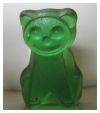Defining a candy as a scientific object.
Maybe I’m too Deriddian, but I know I get uncomfortable when we talk about definition. I found especially surprising to find historians who consider definitions a necessary starting point. “Defining your object of study is an act of clarification about the study itself. Where is the usefulness otherwise? How could you think to produce knowledge?” is more or less the position. But is not in there a too hard constrictive act in selecting just a way or particular ways to interpret a disseminate conceptual history? Isn’t it an arrogant out-of-time and out-of-space attitude, moreover with a high risk in sterility?
Of course scholars need to confront definitions (in the plural) and the continuous production of them. Evidences talk about both their epistemic use and their practical utility. But I would definitely prefer and find more fitting an open comparison of changes and different uses of the same defining words, either in time or in space. A descriptive comparison, which is not intended to arrive to any conclusion. I would also prefer to escape as much as possible ontological attitudes of comparison with unclear and ultra-objectifying “epistemic entities”. Studies such as Geertz’s ones in legal anthropology are to me good methodological examples.
I know this is a completely personal opinion, but this is the reason why I considered attitudes such as attempting univocal definitions of “scientific object” or trying to categorize different “types of scientific objects” with “precise terms” as some of the most dangerous we met during the tour, and definitely not a historian’s task. Moreover, the reduction of “material hermeneutics” to purely verbal cognitive processes like “defining” seems to me at least a curious paradox.
It was precisely for this reason that, after a lecture on medical specimens as scientific objects at the Berlin Medical History Museum of the Charité, I looked at a candy gum on display in a showcase related to knee diseases as a potential deconstructive tool. The exhibition was about “living with prosthesis” and the candy gum was there to suggest an analogous comparison between the materials used to link leg prosthesis to knee-cup, and an object very familiar in the average visitor. So, is the candy gum a scientific object? What is its epistemic value? In that specific context, the candy was probably intended to be a learning tool. But also conceding that we can talk of “epistemic value of scientific objects” only while considering processes of production of scientific knowledge and not at all processes of reception (which I found arbitrary and idealistic), many people could legitimately argue that a scientific process is traceable at an “epistemic entity” level both in the process of production of candies and in the potential analogies they carry. We can’t even know if the analogy suggested to the visitor was in the mind (or in the hands) of a scientist working with prosthesis technology or not. Practices in scientific argumentation (and verbalization) don’t make us sure at all.
I’m quite sure we can’t be sure either in assuming or denying the candy to be a scientific object. But I definitely feel an excess of definition is a risk in historical and anthropological studies as well as in hermeneutics concerned with non-verbal knowledge.

